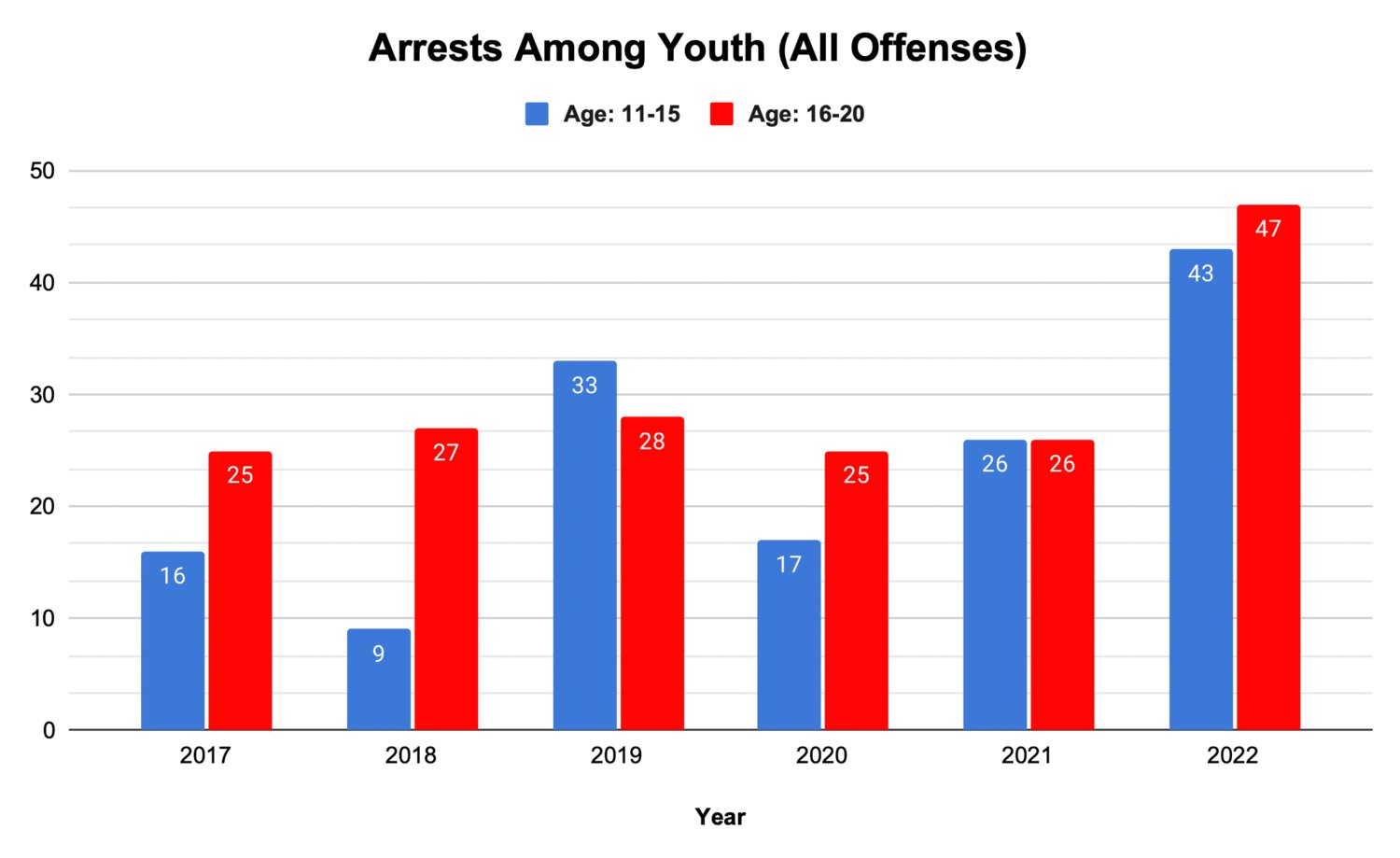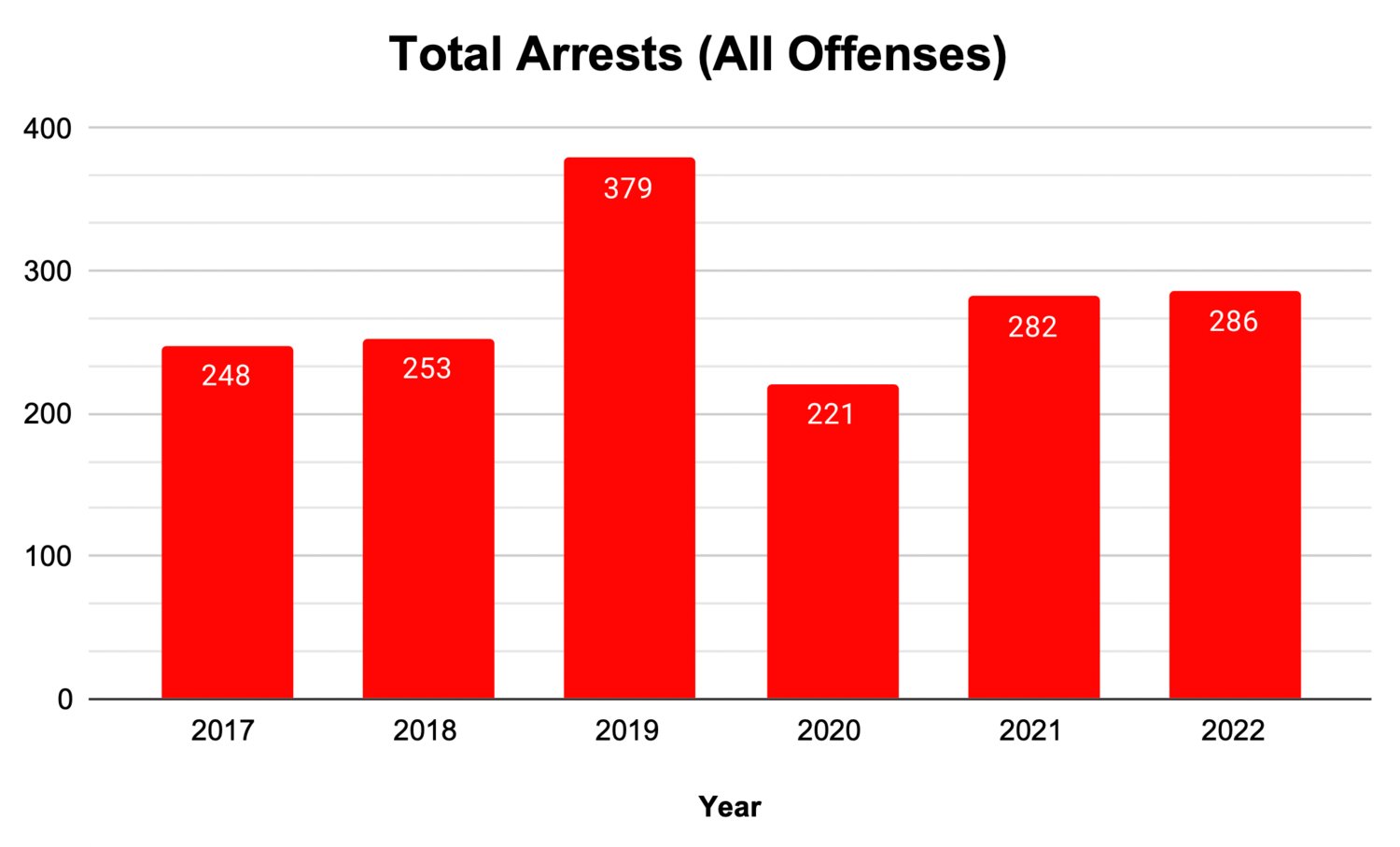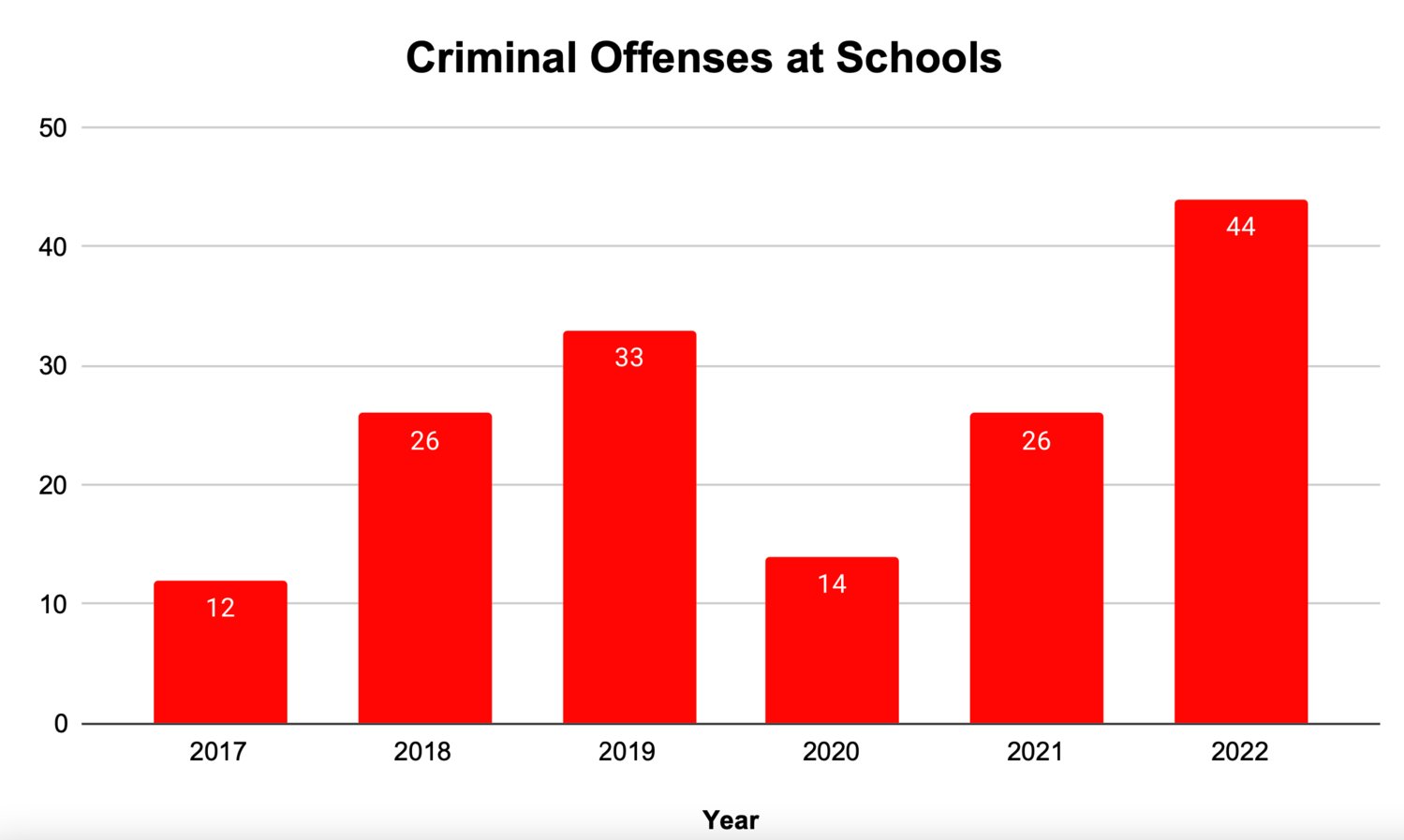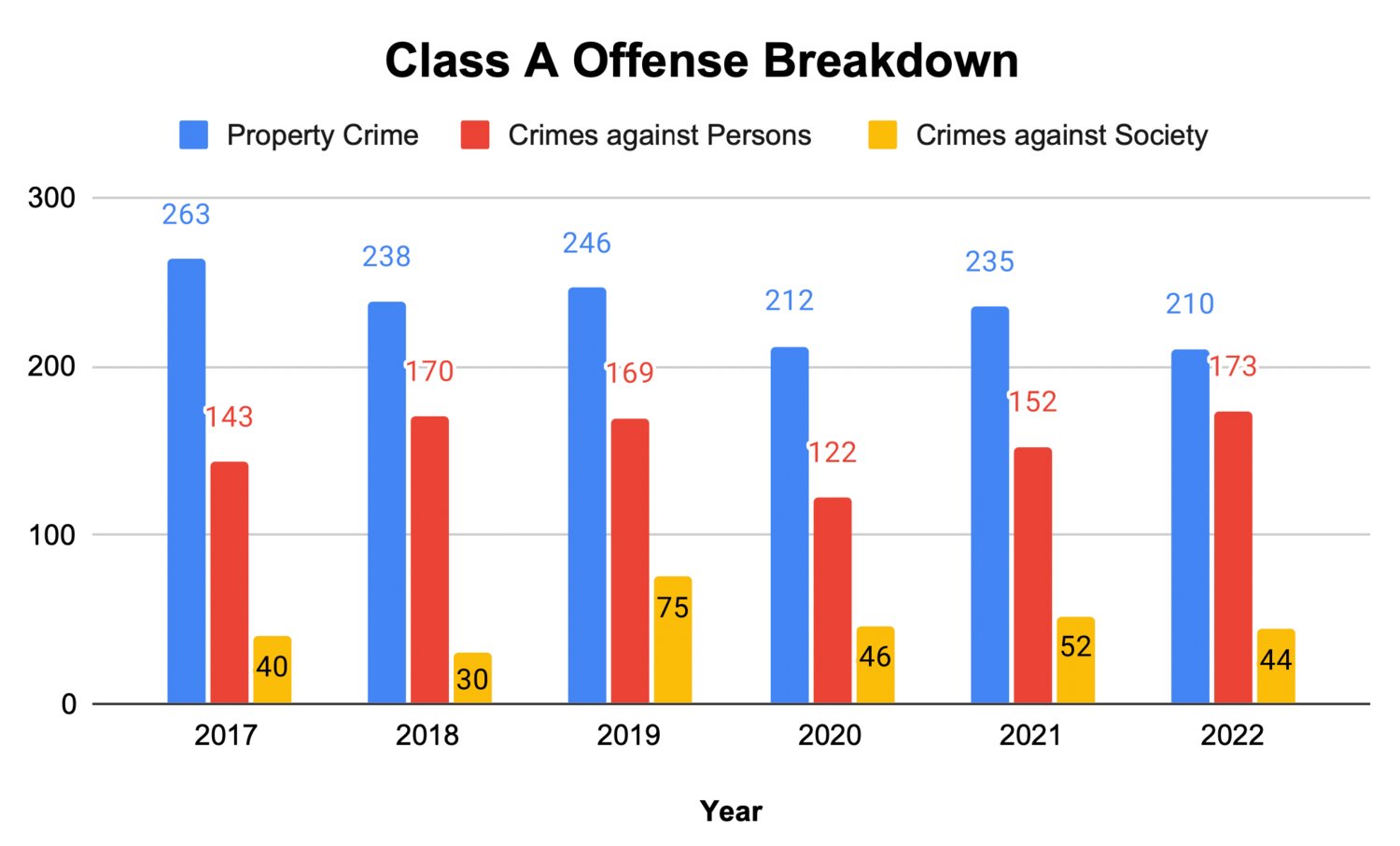Data shows arrests among youth increasing since 2020
Multiple East Bay communities saw highest number of youth arrests in 2021/22
Crime among adolescents and teens has gone up since 2020, with multiple East Bay communities seeing their highest number of arrests in 2021 or 2022. We examine this troubling trend and search for reasons why that might be.
This item is available in full to subscribers.
Please log in to continue |
Register to post eventsIf you'd like to post an event to our calendar, you can create a free account by clicking here. Note that free accounts do not have access to our subscriber-only content. |
Day pass subscribers
Are you a day pass subscriber who needs to log in? Click here to continue.
Data shows arrests among youth increasing since 2020
Multiple East Bay communities saw highest number of youth arrests in 2021/22
Crime in Warren has stayed relatively flat or gone down in recent years, except for one notable category.
Arrests among young people aged 11-15 and aged 16-20 have seen two significant increases from year-to-year — once during a three-year period from 2017 to 2019, and then again from 2020 to 2022, with a lull occurring during the Covid lockdowns of 2020.
In Warren, according to data collected by each municipality and aggregated by the Rhode Island State Police for the federal National Incident-Based Reporting System (NIBRS), crime among youth is at its highest since 2017, which is as far back as the online database goes.
There were 43 arrests among 11-15-year-olds, and 47 arrests among 16-20-year-olds in 2022, which is higher than any previous year reported for either age range, and is the highest since 2019, when 33 youth aged 11-15 were arrested, and 28 individuals aged 16-20 were.
It should be noted that it is difficult to determine any one cause for why crime among youth offenders is on the rise. These numbers on their own are simply that — an examination of numbers in need of more context. The purpose of this piece is merely to identify trends among the data and to promote discussion.
An outlier among other crime trends
One reason the youth arrest numbers stand out is due to the fact that, in Warren, most crime has been either flat, down, or only slightly rising in recent years.
In 2022, there were 286 total arrests among all ages. This is essentially identical to 2021, when there were 282 total arrests, and is down nearly 25% from 2019, when there were 379 total arrests — by far the highest amount in the six years of available data.
Among those numbers are some more interesting data. For example, crimes against property have been trending downward, from a high of 263 incidents in 2017, to 210 incidents in 2022 (down 20%). Crimes against persons, however, are trending upwards since a low-point during 2020. Those crimes have gone up from 122 in 2020, to 152 in 2021, and peaked at their highest number in 2022, with 173 such incidents. However, even that number is relatively flat compared to the 170 crimes against persons that occurred in 2018.
The youth arrest numbers in Warren warrant more analysis and discussion due to their relatively high numbers throughout the past six years that data has been tracked. There were 144 total arrests of kids aged 11-15 between 2017 and 2022 in Warren, compared to 30 in Bristol, 66 in Tiverton, 81 in Barrington, 170 in East Providence, and 199 in Portsmouth.
Crimes occurring on school property see similar rise
When comparing the number of youth arrests and the number of criminal acts that occur on school property (see charts), a similar trend is observed — with a steady rise occurring prior to Covid, an immediate dip during the pandemic year, and then another steady rise in the two years since 2020.
It is important to note that in the case of criminal offenses occurring on school property, not each of these led to an arrest, and they encompass all school property in Warren — from the parking lot at Highlander Charter School, to the playgrounds behind Hugh Cole and Kickemuit Middle School — but the locations of each offense are not disclosed in the database.
There were 44 total crimes committed on school property in 2022, the highest number since data has been logged, which amounts to a nearly 70% increase over 2021, when 26 such acts occurred. The majority of these crimes were listed as simple assaults, while the next most common offense included various types of larceny. Crimes involving narcotics and weapons violations were present, but were not statistically significant.
Reached for comment, Bristol Warren Superintendent Ana Riley said that there were fewer than five incidents from January to December of 2022 where criminal activity occurred in a school building during school hours that prompted a police response. This would mean that the majority of cases involving criminal activity on school grounds was happening outside school hours, not within classrooms or hallways.
“Schools are where kids tend to congregate, in any community,” Riley said, when asked what might be contributing to the data.
When asked if the presence of a school resource officer (SRO) at Kickemuit Middle School — which was implemented in the Fall of 2019, lost funding in 2021, and is now back as of the Fall of 2022 — was contributing to an increase in the number of arrests on school property, Riley said that acting as a traditional police officer was not the role of the SROs.
“They work with the administration. Arrests don’t happen unless they have a conversation with the administration first,” she said. “Particularly because we don’t want school to be a place where kids fear police. The point of having an SRO is to eliminate that and create a community and a positive relationship.”
Police perspective
When asked about the trending increase among youth offenders, Lt. Christopher Perreault said that he didn’t believe the recent trend was unique to Warren.
“I think it’s across the board, not just here in Warren,” he said. “With Covid especially, that social interaction with kids was lacking, and now they’re being put back in the classrooms.”
The data supports this theory, as well. While comparisons between communities should be done with caution considering the different demographics and population sizes, multiple East Bay communities each had their highest number of arrests of 11-15-year-olds on record in either 2022 or 2021. Bristol had 14 in 2022, Barrington had 28 in 2021, Tiverton had 18 in both 2021 and 2022, and Portsmouth had 68 such arrests in 2021.
Warren Police Chief Roy Borges said that the relationship between the police and various community health groups — including the Warren Prevention Coalition, the East Bay Recovery Center, and the Warren Health Equity Zone — along with the SRO now at Kickemuit, has been an ongoing strategy to support better outcomes for youth.
“I think the pandemic and Covid messed us up a little bit. Vaping is big and the students never had that before, so that’s become very popular the last couple of years,” he said, adding that the department has conducted educational awareness programs for the town’s fifth graders in recent years, and that the SRO is active at the parks during the summer. “We’re trying to be as involved as we can in our community for all those reasons,” he said.
But the most useful tool, Perreault and Borges say, comes in the form of the town’s Juvenile Hearing Board, which serves as an additional intervention technique that provides juveniles guilty of minor offenses like substance possession, graffiti, or less serious fights a chance to own up to their mistake, perform some community service, and stay out of the court system entirely.
“We don’t want children to get involved with the court systems, but we do want them to know that you are going to be held accountable for what you’re doing,” Lt. Perreault said. “The juvenile hearing board is something where it’s often their first interaction, and many times the kids who go through that process are not going to reoffend.”
Perreault said that 14 juveniles were referred through the board in 2022. More serious crimes, such as aggravated assaults resulting in injuries, are not eligible to be put before the board. Parents of offending juveniles must also agree to the process, and juveniles must be willing to admit to what they did. A juvenile may also go before the board twice, depending the type of offense and the amount of time between offenses.
“We try to be consistent, but there is a lot of leeway,” Perreault said. “And that’s why the juvenile hearing board works so well, we think. It’s not a one-and-done or very strict on who can go to it.”
Theresa Jeremiah chairs the four-person Juvenile Hearing Board, which is a volunteer board appointed by the Town Council. She has been involved with the board for eight years, inspired to join after the passing of her husband, Jeremiah, who served as the chief judge of the Providence Family Court.
“We try to put the point across that we’re there because we care about them and we don’t get paid, and we’re not meanies. We just don’t want them to get into trouble, because they’re so young,” she said. “These young people are the future of the world. And in our little Town of Warren, maybe we can make changes that really matter for their futures. I’ve just seen too much.”
Observable effects from Covid
When analyzing youth behavioral trends, the effects of Covid cannot be ignored or understated. Especially among adolescents and teens, the consequence of being taken out of school and locked down in their homes with their only connection to friends being through digital screens is a force to be reckoned with.
“There very clearly are trends emerging in terms of data that suggest that kids and adults of all ages have been impacted in a variety of different ways — socially, academically, emotionally,” said Selby Conrad, assistant professor of psychology at Roger Williams University and a practicing child and adolescent psychologist.
Selby said that nationwide data and her own clinical experiences have clearly shown an increase in substance use and anxiety — in both social situations and regarding academics — among adolescents and teens, although she cautioned that there is no one easily definable cause for those observed behaviors. These realities can also have differing manifestations among youth, Conrad said, including withdrawal from social interactions or, conversely, acting out.
“There’s no doubt that in the post-Covid period we’re seeing way more mental health concerns than we did pre-Covid,” Conrad said. “Clinically, I’ve been doing this for 18 years and I haven’t seen this level of stress that kids are under.”
Maria Ursini, program coordinator for the Warren Prevention Coalition, also concurred with the impacts of Covid on kids.
“I think it’s the isolation that these kids had. With parents still working, being at home by themselves and not being with kids their own age. Kids were on Zoom for about a year and a half. If you were a 5th grader going into the middle school, you didn’t actually get there until you were a 7th or even an 8th grader…There’s so many mixed emotions. They’re teenagers, their bodies are changing, there’s so much to it,” she said. “To me, on a personal level, I see that. And that’s why I think we’re having these levels of anxiety, depression, being scared, not knowing what to expect. There’s so much rolled into that.”
Conrad said that the pandemic also put additional stress on the mental healthcare system, making it more difficult for families to access emotional supports for themselves and their kids.
“Somehow we need to increase access to care, but that’s not going to happen quickly because there’s just not enough providers,” she said.
Conrad said that any supports to help kids better identify and healthily deal with their emotions were endeavors worth exploring.
“Anything we can do to support kids, at any age, in helping them identify their feelings — the good and less good — and learning how to express those through healthy communication is great,” she said. “It will only serve them well as they go through life.”













